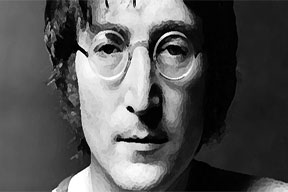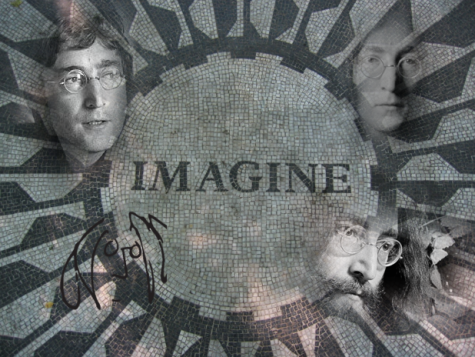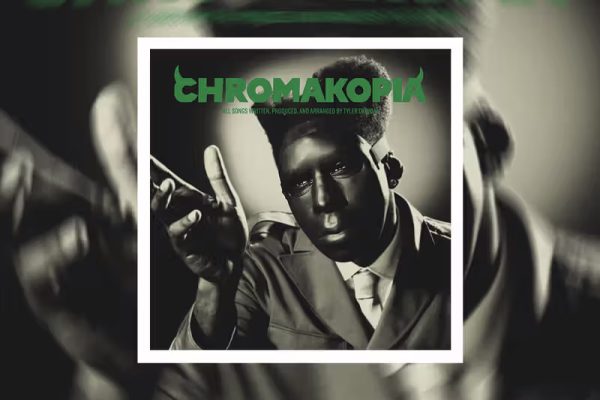Imagining John Lennon 36 years later
Take a look back at a musical icon and the phenomenon that occurred with his passing

John Lennon in 1971 // Edited by Joe Reiter
On October 9th, John Lennon would have been 76 years old. However in 1980, he was tragically shot and killed outside of his Manhattan apartment.
Lennon revolutionized music during the 1960’s, being co-founder and co-songwriter of the most popular band of all time: The Beatles.
As an individual artist, he thrived in the 1970’s, and his song “Imagine” was ranked the third best of all time by Rolling Stone magazine.
An icon is not simply born from sound, but is created through craft, image, and influence.
Lennon, and the Beatles, were at the forefront of musical experimentation in the 1960’s with songs such as “Helter Skelter,” “A Day in the Life,” “Lucy in the Sky with Diamonds,” and many more.
The circular glasses with a hippie hair style was not always Lennon’s look. However, it was the look he wore at the peak of his time with The Beatles and into his individual career during the early 1970’s.
Lennon was a clean cut for the majority of his time with the band, and he even started off with that Elvis Presley greaser look in 1961.
His identity came a long way in the 60’s, and the John Lennon we have all come to remember started to develop in 1967. Around the same time, The Beatles were moving away from their more conventional stuff and into unexplored methods of sound with albums such as Revolver and The Beatles.
Then in 1968 and through early 70’s, the most memorable portrait of Lennon came to be as he fully embraced the psychedelic style; the same looks that pop into our heads when we think of him.

As for influence, Lennon did more than just affect musical culture. His philosophy was exalted by many faithful followers. Whether his ideas be on peace, love, or life, his words seemed to resonate in people.
Well, Lennon is part of a phenomenon. A phenomenon that occurs when a legend is taken away from the world before the world is ready to let him go. Also experienced by musical idols such as Bob Marley and Jimi Henderix.
He died relatively soon after his musical climax, just about 10 years after the Beatles broke up and nine years after the release of his most beloved song, “Imagine.”
Lennon’s final song, “Watching the Wheels“, was released after his murder, and it reached number 10 on the Billboard Hot 100, and was number 30 on the charts in the UK.
Almost all people will fail the test of time, but Lennon never had to finish that test. His career never fell into oblivion, he never teetered completely out of the picture, and his premature death helped him dodge this reality.
In this way, Lennon becomes almost like a myth. He feels distant and almost surreal: a musical revolutionist that we will never be able to see or know, only remember. A remembrance that will not be tarnished by the effects of being human.
He has physically been long gone from the world, but his work and ideas did not leave with him.
Still, the people listen.
His essence flows through the decades and the generations; giving him, or at least his influence, a sense of immortality.
Circular glasses, long hair, youthful yet worn in complexion, that is John Lennon. Although he may not be here, he is sure not done yet.
Ob la di ob la da life goes on bra
La la how the life goes on


I am a senior, and a first year Quill writer here to bring the news to you one swift stroke of the pen at a time. I run cross country and track with the...











Joe Sloan • Oct 19, 2016 at 1:56 pm
Only a few quibbles with your piece:
1. Helter Skelter was Paul’s song. If you want to list Lennon songs that were at the “forefront of musical experimentation”, you could have opted for Strawberry Fields Forever, Revolution, or Tomorrow Never Knows.
2. The picture you have from 1964 is definitely not from that year. It appears to be from 1966.
3. You ended the article with a quote from Ob-La-Di, Ob-La-Da. Once again, this was Paul’s song. What’s more, Lennon hated it! He is on record during his last interview in 1980 with Playboy saying as much. I think you set up Imagine or even Watching the Wheels as obvious choices for your last quote, so I was a bit surprised by your choice.
But I am glad you are interested in John Lennon even though he probably died long before you were born! Hats off for the effort. Check out the essential book Beatlesongs, by William J. Dowlding, if you want a refresher on who wrote what Beatles song and the members’ impressions of said songs…